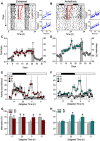Scheduled feeding restores memory and modulates c-Fos expression in the suprachiasmatic nucleus and septohippocampal complex
- PMID: 28754901
- PMCID: PMC5533780
- DOI: 10.1038/s41598-017-06963-w
Scheduled feeding restores memory and modulates c-Fos expression in the suprachiasmatic nucleus and septohippocampal complex
Abstract
Disruptions in circadian timing impair spatial memory in humans and rodents. Circadian-arrhythmic Siberian hamsters (Phodopus sungorus) exhibit substantial deficits in spatial working memory as assessed by a spontaneous alternation (SA) task. The present study found that daily scheduled feeding rescued spatial memory deficits in these arrhythmic animals. Improvements in memory persisted for at least 3 weeks after the arrhythmic hamsters were switched back to ad libitum feeding. During ad libitum feeding, locomotor activity resumed its arrhythmic state, but performance on the SA task varied across the day with a peak in daily performance that corresponded to the previous daily window of food anticipation. At the end of scheduled feeding, c-Fos brain mapping revealed differential gene expression in entrained versus arrhythmic hamsters in the suprachiasmatic nucleus (SCN) that paralleled changes in the medial septum and hippocampus, but not in other neural structures. These data show that scheduled feeding can improve cognitive performance when SCN timing has been compromised, possibly by coordinating activity in the SCN and septohippocampal pathway.
Conflict of interest statement
The authors declare that they have no competing interests.
Figures





Similar articles
-
Light induces c-fos and per1 expression in the suprachiasmatic nucleus of arrhythmic hamsters.Am J Physiol Regul Integr Comp Physiol. 2005 Nov;289(5):R1381-6. doi: 10.1152/ajpregu.00695.2004. Epub 2005 Jul 7. Am J Physiol Regul Integr Comp Physiol. 2005. PMID: 16002555
-
Light-induced c-Fos expression in the SCN and behavioural phase shifts of Djungarian hamsters with a delayed activity onset.Chronobiol Int. 2015 Jun;32(5):596-607. doi: 10.3109/07420528.2015.1018422. Epub 2015 May 4. Chronobiol Int. 2015. PMID: 25938796
-
Spatial memory and long-term object recognition are impaired by circadian arrhythmia and restored by the GABAAAntagonist pentylenetetrazole.PLoS One. 2013 Aug 29;8(8):e72433. doi: 10.1371/journal.pone.0072433. eCollection 2013. PLoS One. 2013. PMID: 24009680 Free PMC article.
-
Hamsters running on time: is the lateral habenula a part of the clock?Chronobiol Int. 2006;23(1-2):217-24. doi: 10.1080/07420520500521947. Chronobiol Int. 2006. PMID: 16687295 Review.
-
Suppression of Circadian Timing and Its Impact on the Hippocampus.Front Neurosci. 2021 Apr 8;15:642376. doi: 10.3389/fnins.2021.642376. eCollection 2021. Front Neurosci. 2021. PMID: 33897354 Free PMC article. Review.
Cited by
-
Impaired Morris water task retention following T21 light dark cycle exposure is not due to reduced hippocampal c-FOS expression.Front Behav Neurosci. 2022 Oct 12;16:1025388. doi: 10.3389/fnbeh.2022.1025388. eCollection 2022. Front Behav Neurosci. 2022. PMID: 36311860 Free PMC article.
-
Signalling pathways contributing to learning and memory deficits in the Ts65Dn mouse model of Down syndrome.Neuronal Signal. 2021 Mar 12;5(1):NS20200011. doi: 10.1042/NS20200011. eCollection 2021 Apr. Neuronal Signal. 2021. PMID: 33763235 Free PMC article. Review.
-
The Effect of Calorie Restriction and Intermittent Fasting on Impaired Cognitive Function in High-Fat Diet-Induced Obesity Started Post-Weaning in Male Wistar Rat.Med J Islam Repub Iran. 2022 Feb 21;36:12. doi: 10.47176/mjiri.36.12. eCollection 2022. Med J Islam Repub Iran. 2022. PMID: 35999941 Free PMC article.
-
Circadian Interventions in Preclinical Models of Huntington's Disease: A Narrative Review.Biomedicines. 2024 Aug 6;12(8):1777. doi: 10.3390/biomedicines12081777. Biomedicines. 2024. PMID: 39200241 Free PMC article. Review.
-
Reversible Suppression of Fear Memory Recall by Transient Circadian Arrhythmia.Front Integr Neurosci. 2022 May 27;16:900620. doi: 10.3389/fnint.2022.900620. eCollection 2022. Front Integr Neurosci. 2022. PMID: 35694186 Free PMC article.
References
Publication types
MeSH terms
Substances
Grants and funding
LinkOut - more resources
Full Text Sources
Other Literature Sources

